colonizing Oceania and Australasia
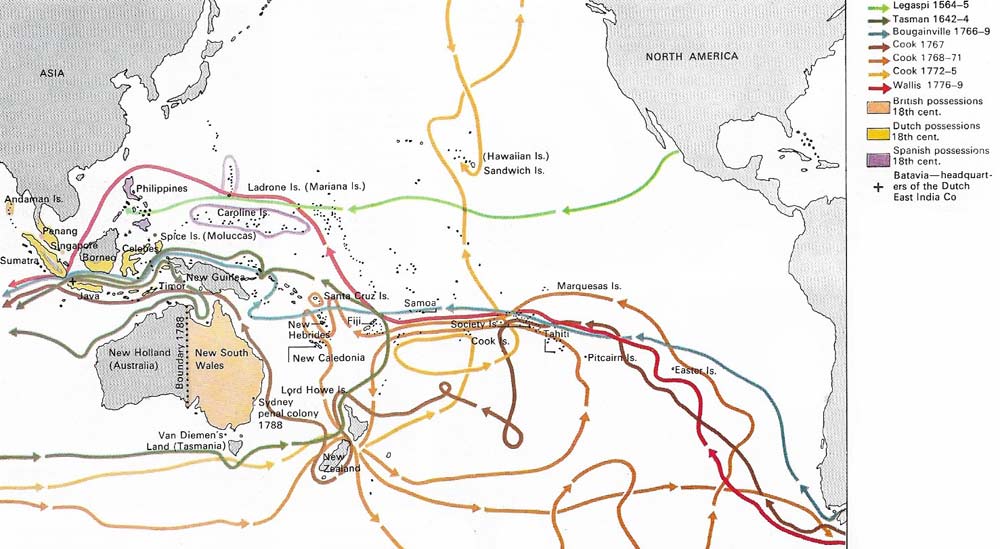
Figure 1. Imperial ambition, commercial rivalry, and the search for a legendary southern continent motivated navigators of the great European maritime nations – Spain, Portugal, Holland, England and France – to explore the Pacific between the 16th and 18th centuries. They included Legaspi, who conquered the Philippines, Tasman, the discoverer of Tasmania and New Zealand, Bougainville, first Frenchman to sail round the world, Wallis, the English discoverer of Tahiti, and Cook, whose three voyages opened up most of the Pacific.

Figure 2. Explorers during the first half of the 19th century sailed round the uncharted coasts of Australia and probed the interior from settled areas in the southeast. They journeyed up the great rivers and across mountains and deserts in search of fertile land and an inland sea which they believed to exist. Later explorers, mostly from Europe, established that the heart of the Australian continent was barren.
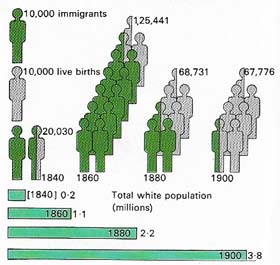
Figure 3. Australia relied initially on immigration to build up its population. An assisted immigration scheme was introduced in 1829 and up to 1860 immigrants accounted for over three-quarters of the population growth. The gold rushes of 1851–1856 brought an even greater immigrant surge, thereafter, the Australian birthrate began to rise and overshadow a reduced flow of immigrants.
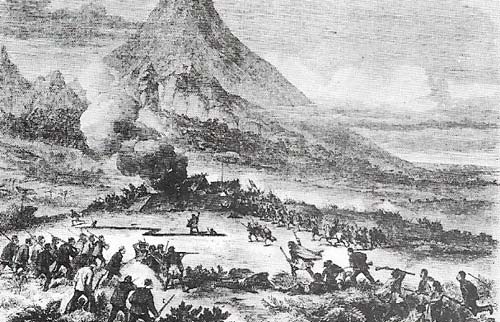
Figure 4. Māori gallantry against superior weaponry marked many battles during the 1860s when Crown attempts to satisfy the land hunger of New Zealand settlers without disrupting Māori tribal rights broke down on bitter disputes over land sales. Māoris defended redoubt such as this one above the Kitikara Stream near Mt Egmont. In 1863 the fort was battered by naval guns and 350 troops routed 600 Māoris.
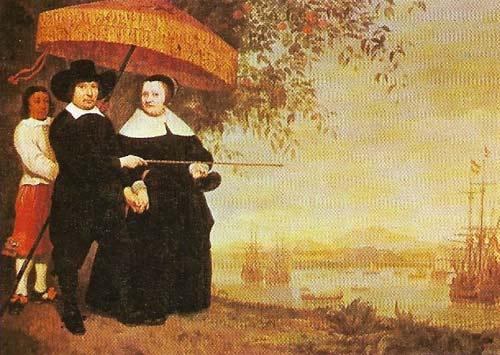
Figure 5. The fortress port of Batavia was the trade center of the Indies in the 17th century when Aelbert Cuyp (1620–1691) painted "The Return Fleet of the East India Company on the Roads of Batavia". Dutch naval supremacy and commercial enterprise, backed when necessary by guns, led to the establishment of a colonial empire that lasted 300 years. Batavia eventually reverted to its former name of Jakarta as the capital of the independent nation of Indonesia.
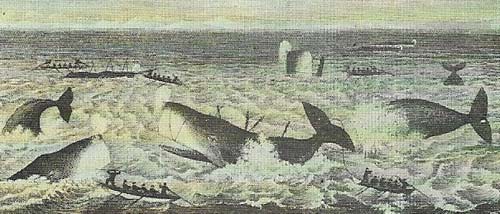
Figure 6. Whalers, along with traders and blackbirders, brought guns and disease to many Pacific islands in the 19th century. The profitability of whaling meant that fishing grounds were rapidly depleted, although the industry survived for many years. This somewhat fanciful print entitled "The North Cape New Zealand and Sperm Whale Fishery" may exaggerate the density of the whale population but typifies the old-style shore whaling practices which led to many coastal settlements.
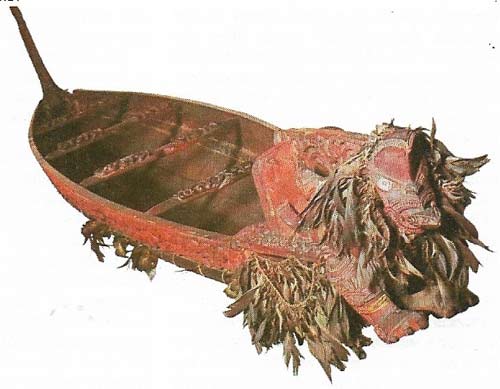
Figure 7. The Māoris of New Zealand, whose Polynesian ancestors paddled some 3,300 kilometers (2,000 miles) across the Pacific in about the 13th century, were unsurpassed craftsmen of dugout canoes, of which a model is shown here. Their war canoes, carrying up to 100 men, were elaborately carved by sculptors who also taught their pupils the magical and religious ritual associated with the craft. Paddled at full speed, they could overtake European sailing ships.
The voyage of Ferdinand Magellan across the "Peaceful Sea" in 1520 brought the Pacific Ocean to the attention of Europe. But it was 1565 before the Spaniard Lopez de Legaspi (died 1572), sailing west from the New World, settled the Philippines, where Magellan had died (Figure 1). Spanish rule, although challenged, was uninterrupted until the Spanish-American War of 1898, when the Philippines were ceded to the United States.
The Indies and Australia
Meanwhile to the southeast, as Portuguese power declined, the ships of the Dutch East India Company, founded in 1602, routed the pirates of the Malay Archipelago, seized control of the lucrative spice trade and paved the way for a Dutch colonial empire extending from Sumatra, Java, and Borneo to Celebes, the Moluccas and western New Guinea (Figure 5). The prosperity of the new colonies, largely derived from cloves, nutmeg, pepper, and coffee, was set against a background of repression and bloodshed. In Borneo, where gold and diamond mining attracted Chinese immigration, Dutch rule was precarious; and not until 1701 did the British East India Company, formed in 1600, establish a factory or trading post in what later became a permanently divided island.
Commissioned by East Indies Governor Anthony van Diemen (1593–1645) to chart the western and southern shores of New Holland (Australia), Abel Tasman in 1642-1643 discovered Van Diemen's Land (later Tasmania), skirted New Zealand and later sailed along the southern coast of New Guinea into the Gulf of Carpentaria. More than a century passed before the British Admiralty dispatched James Cook (1728–1779) to take possession of any land in the south in the course of a scientific expedition to the South Seas. By sailing during 1768–1771 from Cape Horn to New Zealand (which he charted as two islands) Cook finally exploded the theory that a great southern continent balanced the land mass of the Northern Hemisphere. He sailed up the east coast of Australia, claiming it for Britain, showed that New Guinea was a separate island and, in two later voyages, made other significant Pacific discoveries.
 |
| Abel Tasman (1603– c. 1659), an employee of Dutch East India Company, touched on the southern shore of an island he named Van Diemen's Land (after the Indies' Governor-General) in 1865 the island was renamed Tasmania. He was deterred from landing in New Zealand by war-like Māoris. After discovering Tonga and the Fiji islands he returned returned to Batavia where he was rebuked for "having been negligent in investigating the situation, conformation and nature of the lands and peoples discovered". An equally frosty reception greeted his second voyage along the south coast of New Guinea and north Australia. |
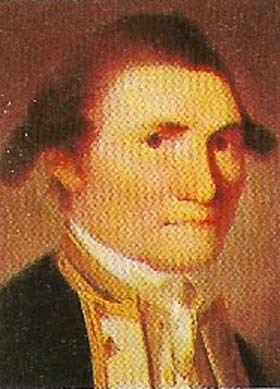 |
| The voyages of Captain James Cook were supplemented by careful and perceptive accounts of lands he visited and by scientific observations of great practical value. During his first voyage in Endeavour in 1768–1771 he circumnavigated the two main islands of New Zealand, charted and claimed the east coast of Australia and returned home through the Torres Strait. In the second voyage he took Resolution to the Antarctic and discovered or rediscovered many Pacific islands. Finally, he visited Australia and New Zealand again in Resolution and discovered Hawaii, where he was killed in 1779. |
Britain was left to colonize the vast subcontinent of Australia in 1787, first as a penal settlement, later as rich sheep and cattle country. Population was concentrated in the east and south where Brisbane, Sydney, Melbourne, and Adelaide were founded. Sparse settlement spread out as explorers trekked across the vast deserts of the interior (Figure 2). The principal victims of white expansion were the nomadic Aborigines, their Stone Age culture based entirely on hunting, their clubs, spears, and boomerangs ineffectual against firearms. Introduced diseases had an even more devastating impact. Guns and epidemics wiped out the native population of Tasmania and sharply reduced that of the mainland. The Aborigines were to have no share in new Australian prosperity, accelerated by later gold rushes (Fig 3).
New Guinea and New Zealand
Rumors of gold also drew prospectors to the great island of New Guinea in the mid-nineteenth century. Mineral resources proved negligible but traders and speculators stripped coastal forests of timber. In the mountainous interior, inhabited by plumed and painted headhunters, civilizations made little impact even when Holland, Germany and Britain annexed the island in 1884–1885.
In New Zealand the Maoris, more advanced socially and culturally, were treated with more respect by European settlers. Whalers (Figure 6) and sealers were initially welcomed by the local population although disease took a terrible toll. The early nineteenth-century arrival of traders and missionaries in the North Island was followed by British annexation with Maori agreement in 1840 and rapid settlement of both islands. But misunderstandings over tribal rights to sell land to the colonists led to disputes as the Maoris realized the threat to their lands. They resisted in a series of fierce wars, particularly in the 1860s (Figure 4) but were defeated, lost most of their land despite nominal consultation and thus faced the future with a great deal of misgiving.
The Maoris had left their original homelands in Polynesia several centuries earlier. Other peoples – Micronesians, Melanesians, and Polynesians – still inhabited the island groups of Oceania that were sighted (and often colonized) by Europeans between the 16th and 19th centuries. Dried coconut (copra), used for animal feeding and later for the extraction of edible oil, was the staple export crop. A few islands were commercially more rewarding – notably British Fiji with its forests of sandalwood; French New Caledonia, where nickel was found; and Hawaii, where a combination of American missionary work and enlightened local rule led to independence as early as 1843; a prosperous economy based on sugar and pineapples thereafter developed.
 |
| William Dampier (1652–1715), formerly an English buccaneer, explored the coasts of Australia, New Guinea, and New Britain, vividly describing lands and people. |
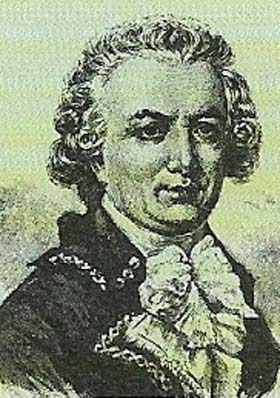 |
| Louis de Bougainville (1729–1811) set out on a round-the-world voyage of discovery in November 1766 in the frigate La Boudeuse. He sailed there the Straits of Magellan to the Tuamotus and Tahiti, which he claimed for France, unaware that Samuel Wallis (1728–1795) had found it ten months earlier. He sighted and named islands in the Samoa and New Hebrides groups and would have reached the unknown east coast of Australia had he not been diverted by the Great Barrier Reef. Despite starvation and scurvy he had lost only seven men by the time he returned home in 1769. He also founded a settlement in the Falkland Islands. |
Cultural impact
Elsewhere, repression, missionary conversion, disease and "blackbirding" – the forced transport of native labor to work in the sugar and cotton plantations of Fiji and Queensland – all helped to destroy local cultures and tribal structures as white civilization spread. Colonialism also put a stop to more savage rituals – cannibalism, headhunting, and blood feuds – with a promise of improved education and a share in economic wealth and political power.
